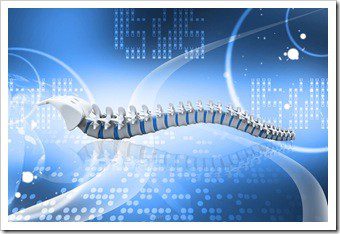
Living a high paced lifestyle of fast cars, fast computers, and fast food is not only accelerating our excitement and experiences but accelerating the age of our bodies. Our bodies are no longer able to replenish vital systems as fast as our bodies are depleting them. This system failure is seen across the human dashboard with warning lights for the immune, organ, and structural bone system. Our skin can exhibit luster in appearance, but what about the one beneath the hood – our skeletal system?
Osteoporosis: What is it?
Osteoporosis is a chronic, progressive disease of the skeletal system. Bone is living tissue, which is constantly being absorbed and replaced. Osteoporosis occurs when the creation of new bone does not keep up with the removal of old bone. The ineffective reproduction reduces the amount of bone strength you have in your body, making you susceptible to fractures, especially of the hip, spine, and wrist. Any fracture is disabling, but in older people, they can prove fatal. It may surprise you to know that 50% of women and one in eight men will suffer an osteoporosis-related fracture at some point in their life.
Osteoporosis is not the same as arthritis. The difference is that there is no pain from osteoporosis until a fracture happens. The absence of swollen and painful joints does not indicate an absence of osteoporosis because these symptoms related to arthritis. It is, therefore, sensible to be proactive and begin living a healthier lifestyle. These additions should embrace regular maintenance checks, which include posture malignment, and adding a higher octane of fuel – a better quality food.
Great Instruction Manual Information
- Regular exercise, such as walking, rope-jumping, jogging, racquet sports, swimming or aerobics. Do this for a minimum of 20 minutes three times a week to help strengthen bones and reduce the risk of osteoporosis.
- Weight-lifting is known to trigger an increase in bone density, so this is an excellent way to guard against osteoporosis. However, medical advice on weight-lifting should be sought if you already have the condition to avoid putting excess strain on already-brittle bones.
- Tai Chi, which is a slow and gentle form of martial arts, is a useful strength training exercise. It is beneficial for all; even if, you have severe osteoporosis or have already suffered fractures.
Care should be taken when bending or lifting objects if you already have osteoporosis. Make sure to bend at the knees, not at the waist, and keep the object close into your body. Also, try to avoid sitting or standing in a hunched position. - Incorporate a sufficient intake of calcium-enriched foods rich in Vitamin D3 or supplements. The recommended daily amounts are 1,000 mg/day for postmenopausal women taking estrogen, and 1,500 mg/day for postmenopausal women not taking estrogen and for men over 65 years of age.
- The best types of calcium supplements are the most absorbable, such as microcrystalline hydroxyapatite concentrate (MCHC), or one of the malates, fumarates, succinates, glutarates, or citrates. Keep to the recommended doses, though, because too much can lead to kidney stones.
- Additional nutritional supplements, such as vitamin C, magnesium, zinc and silica may be of use but talk to your Chiropractor first.
- Eat a healthy, balanced diet. Include green leafy vegetables, fruit, nuts, and seeds. Raw sesame seeds contain more calcium than any other food on earth. Limit your intake of animal protein, baked goods, and junk food.
- Drink eight eight-ounce glasses of water a day. That’s water, not teas, juices or coffee. Try to avoid caffeine, sodas, and alcohol.
A Road Hazard – Dairy
If you’re wondering why you did not see milk or cheese in the above food list, it’s because dairy products DO NOT guard against osteoporosis. Plus, over-consumption has proven to be detrimental. Here’s why:
The number one cause is the processing of dairy products, such as pasteurization and homogenization. These processes degrade the calcium to a point where it becomes challenging to digest.
Steroid hormones in dairy products can be counted as significant risk factors for various cancers in humans.
The enzymes needed to break down and digest milk – renin and lactase – are no longer present in humans past around three years of age.
There is 300 times more casein in cow’s milk than in human milk, which clogs and burdens the system as it can no longer be broken down.
The calcium in cow’s milk is far coarser than in human milk, and it is dense with casein; thus it is not easily absorbed.
Research shows that D-galactose, found in milk, induces oxidative stress damage, and chronic inflammation. These changes have been associated with cardiovascular disease, cancer, bone loss, and muscle loss.
And here’s the killer: one of the major roles of calcium in the human body is to neutralize the acid. Dairy products are extremely acid-forming. Thus the net impact of consuming dairy is that your system actually loses calcium in its vain attempt to deal with its negative effects.
Chiropractic – Great Road Protection
Our healthcare practice specializes in helping patients who not only have osteoporosis but wonderful residents who look for ways to live healthier natural lifestyles. We invite you to come and ask any questions that you may have in regards to how wellness and chiropractic care can help.
Our mission is to serve and provide our community with a future “built to last” healthcare solution. We aim to help our community grow to be one of the healthiest on the planet.
For Your Health,
Dr. Steven M. Gillis

